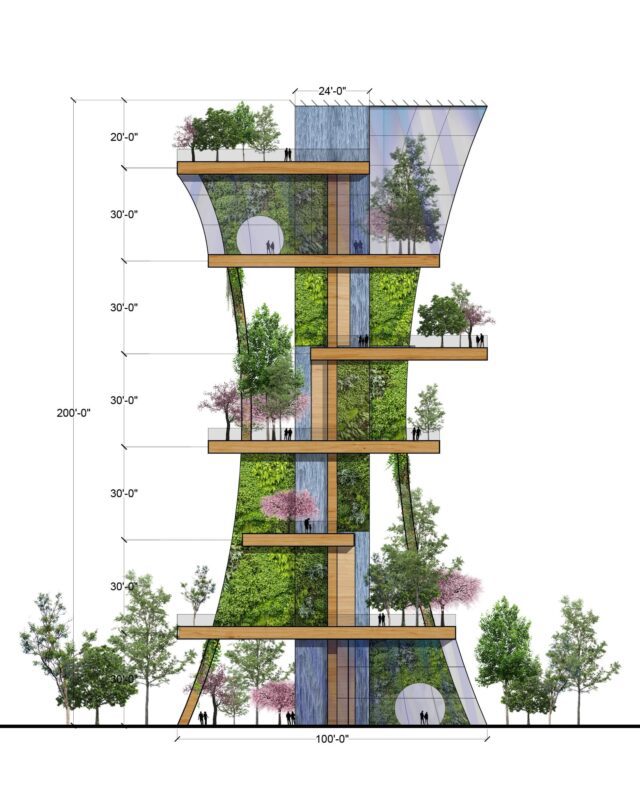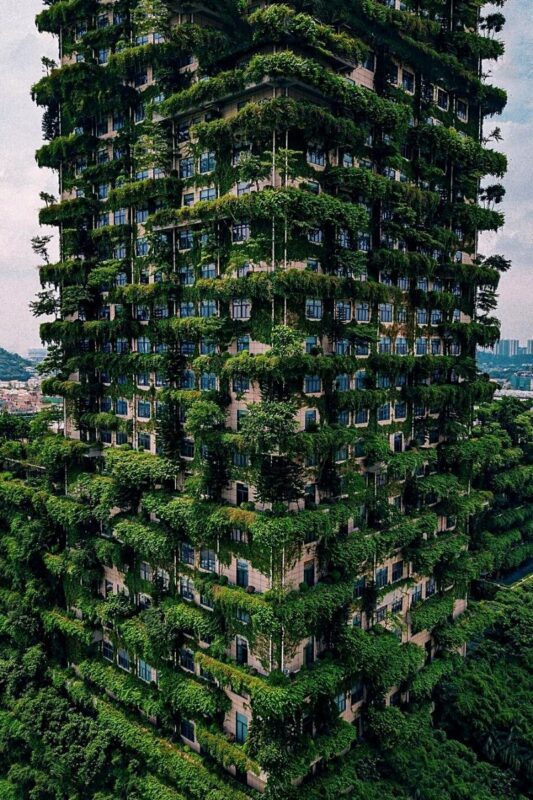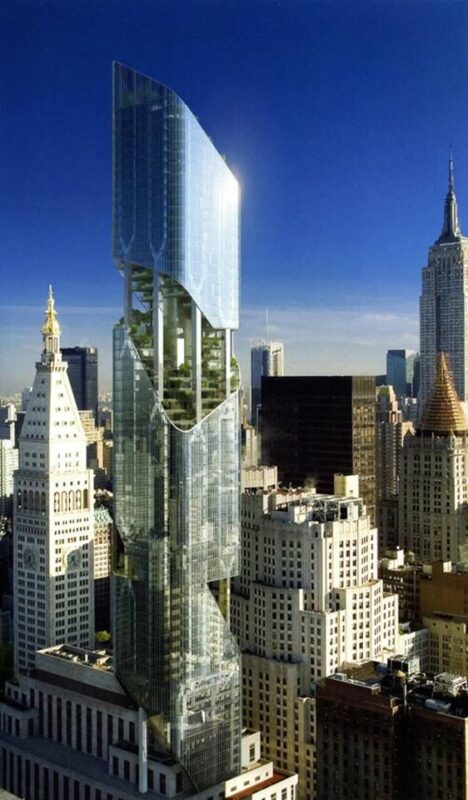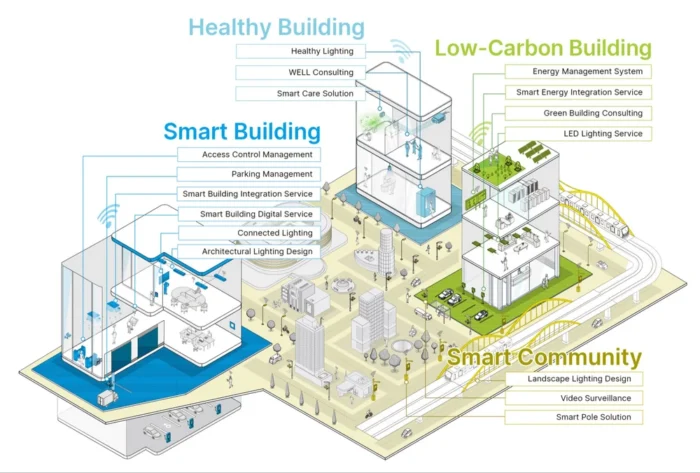Beyond Green: The Next Generation of Net-Zero Skyscrapers and Their Revolutionary Impact
Most of what we call “sustainable architecture” today is theater. Architects celebrate LEED certifications and solar panel installations while cities choke on carbon emissions. Our tallest skyscrapers still consume energy like hungry machines. But net zero skyscrapers are about to change everything we know about sustainable high-rise design.
The future of vertical cities isn’t just carbon-neutral. It’s carbon-negative, self-healing, and more intelligent than the architects who designed them. From diagrid structures that move with the wind to passive cooling systems that eliminate traditional HVAC, the next generation of skyscrapers isn’t pushing boundaries—it’s destroying them completely.
What Makes a High-Rise Building Truly Sustainable in 2025?
True sustainability in net zero skyscrapers means rethinking everything. That new office tower with its green roof and recycled steel frame still pumps out more carbon than a small town. Real sustainable architecture demands a shift from “less bad” to “regenerative good.” We’re talking about buildings that produce more energy than they consume, pull carbon from the atmosphere, and adapt their performance in real-time.
Beyond Solar Panels: The Real Revolution
Everyone obsesses over solar panels and green walls, but the real revolution happens in materials science, artificial intelligence, and biomimetic design. The latest bio-concrete contains limestone-producing bacteria that heal cracks while absorbing CO2 from the air. Smart glass adjusts its opacity and thermal properties 40,000 times per day, responding to sun angles, weather patterns, and occupancy levels with Swiss watch precision.
Living Buildings That Breathe
The most sustainable net zero skyscrapers of 2025 might not look like buildings at all. They’re living ecosystems wrapped in responsive skins, breathing structures that pulse with nature’s rhythms while housing thousands of people. This isn’t architectural fantasy—it’s engineering -reality happening right now in laboratories and construction sites from Singapore to Stockholm.
What Are the Latest Trends in High-Rise Architecture That Actually Matter?
The real visionaries are asking different questions: What if a building could grow its own structure? What if waste heat from one floor could power another? What if the building envelope could harvest water from humidity while generating electricity from wind pressure? The latest trends aren’t stylistic—they’re metabolic.
The Rise of Living Architecture
We’re witnessing the emergence of “living architecture”: buildings that function more like organisms than objects. These structures feature adaptive facades that respond to environmental changes, integrated algae bioreactors that purify air while producing biomass, and structural systems that strengthen over time through engineered biological processes.
Smart Modular Construction
The breakthrough in modular construction technology is reshaping how we think about tall buildings. These aren’t prefab units—they’re precision-engineered components with embedded sensors, self-assembling joints, and integrated renewable energy systems. Construction time for a 50-story building has dropped from three years to eighteen months, while energy performance has improved by 60% compared to conventional construction.
Swarm Intelligence in Buildings
The real trend that’s about to disrupt everything? Swarm intelligence applied to building systems. Imagine thousands of microscopic sensors throughout a net zero skyscraper’s structure, communicating in real-time to optimize everything from structural load distribution to indoor air quality. The building doesn’t just respond to its environment—it learns, adapts, and evolves.
How Do Green Building Systems Work in Tall Buildings When They Actually Work?
Most architects treat green building systems like accessories—add-ons to make conventional buildings slightly less destructive. But truly sustainable architecture requires integrated systems thinking that treats the entire building as a single, complex organism.
Integrated System Loops
The breakthrough isn’t in individual technologies—it’s in the symphony of interconnected systems. Advanced buildings now feature integrated loops where waste heat from data centers powers radiant heating systems, while greywater recycling feeds vertical farms that provide fresh air filtration. The building’s passive cooling systems work in harmony with natural ventilation strategies that harness stack effect principles to create airflow patterns.
Predictive Building Intelligence
The most revolutionary development is in predictive building intelligence. These systems don’t just respond to current conditions—they anticipate future needs based on weather forecasts, occupancy patterns, and energy grid demands. The building pre-cools itself before a heat wave, adjusts its thermal mass to store renewable energy, and coordinates with other buildings in the district to optimize collective performance.
Natural Process Integration
The secret sauce isn’t technology alone—it’s integrating natural processes with engineered systems. Buildings that incorporate architectural solutions for plastic pollution while producing clean energy and fresh water aren’t just sustainable—they’re regenerative. They give back more than they take.
What Are the Challenges of Designing Super Tall Buildings That Nobody Talks About?
The challenge isn’t just structural—it’s existential. How do you design a building that will stand for 100 years when climate models for the next 50 years show conditions outside historical precedent? Net zero skyscrapers face wind speeds, temperature fluctuations, and precipitation patterns that push traditional engineering assumptions to their breaking point.
The Human Psychology Problem
We’re designing vertical cities for thousands of people, but our understanding of how humans function in super-tall environments is primitive. How does spending 8 hours a day 800 feet above ground level affect circadian rhythms, stress hormones, and social behavior? We’re conducting a massive, uncontrolled experiment on human physiology.
Structural Precision Demands
The structural challenges are equally fascinating and terrifying. Diagrid structures can handle incredible loads while reducing material usage by 30%, but they require manufacturing precision that pushes current fabrication technology to its limits. A single miscalculation in joint tolerances can cascade through the entire structural system, creating stress concentrations that won’t manifest as failures for decades.
The AI Intelligence Dilemma
What happens when these super-intelligent buildings become too intelligent? When building AI systems start making optimization decisions that prioritize energy efficiency over human comfort, or structural integrity over operational costs? We’re creating buildings that can think, but we haven’t solved the problem of making sure they think like us.
How Do Smart Building Technologies Improve High-Rise Efficiency When They’re Not Just Marketing Hype?
Smart building technology has a credibility problem. For every genuinely revolutionary system, there are ten “smart” thermostats that couldn’t outsmart a paper bag. But buried beneath the marketing noise are technologies so advanced they make traditional building automation systems look like stone tools.
Digital Nervous Systems
Real smart building technology isn’t about apps and dashboards—it’s about creating digital nervous systems that extend throughout every structural element, facade component, and mechanical system. These buildings don’t just collect data; they develop intuition. They learn that Conference Room B always runs hot during afternoon meetings, that the northwest corner needs extra heating on cloudy days, and that elevator traffic patterns change based on cafeteria menu selections.
Interconnected Intelligence Networks
The breakthrough technologies aren’t individual sensors—they’re networks of interconnected systems that create emergent intelligence. Building-integrated photovoltaics that adjust their angle throughout the day while serving as structural glazing. Thermal mass systems that store and release energy based on predictive algorithms that consider weather forecasts, occupancy schedules, and grid electricity pricing. Ventilation systems that create micro-climates within floors, optimizing air quality and temperature for different activities and occupant preferences.
Urban Infrastructure Coordination
The real breakthrough is when these systems start talking to each other and to the broader urban infrastructure. Buildings that coordinate with electrical grids to provide demand response services. Structures that communicate with public transportation systems to optimize lobby traffic flow. Net zero skyscrapers that share thermal energy with neighboring buildings through district-level heat exchangers.
Exponential Efficiency Gains
The efficiency improvements aren’t incremental—they’re exponential. Buildings that consume 80% less energy than code requirements while providing superior indoor environmental quality. Structures that generate more renewable energy than they use while serving as urban-scale air purification systems.
The Uncomfortable Questions We Need to Ask
The architectural establishment doesn’t want to admit this: we’re designing the future of human habitation while clinging to 20th-century assumptions about how buildings should work. The technologies exist today to create net zero skyscrapers that are carbon-negative, self-repairing, and more responsive to human needs than any building in history. So why aren’t we building them?
Cultural Barriers to Innovation
The answer isn’t technical—it’s cultural. We’re trapped by building codes written for a stable climate, financing models that reward short-term thinking, and professional liability systems that punish innovation. We’re designing buildings for a world that no longer exists while pretending that incremental improvements will solve exponential problems.
The Human-AI Partnership Question
Are we ready for buildings that are smarter than their architects? When AI systems can optimize structural performance, energy efficiency, and occupant comfort simultaneously, what’s left for human designers? Maybe we should be asking: when buildings can think, what will they think of us?
The Living Future
The next generation of net zero skyscrapers isn’t just changing how we build—it’s changing what it means to inhabit space. These aren’t just structures; they’re partners in creating a livable future. The question isn’t whether we can build them. The question is whether we’re brave enough to live in them.
The revolution isn’t coming—it’s here. The only question is whether the architectural profession will lead it or be swept away by it. What side of history will you choose?
Tags: building automation systemsgreen building systemshigh-rise building design trendsModular Constructionnet-zero skyscrapersrenewable energy integrationsmart building technologysuper tall building challengessustainable architecture innovationsustainable high-rise architecture
Ruba Ahmed, a senior project editor at Arch2O and an Alexandria University graduate, has reviewed hundreds of architectural projects with precision and insight. Specializing in architecture and urban design, she excels in project curation, topic selection, and interdepartmental collaboration. Her dedication and expertise make her a pivotal asset to Arch2O.






